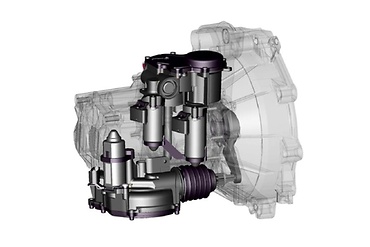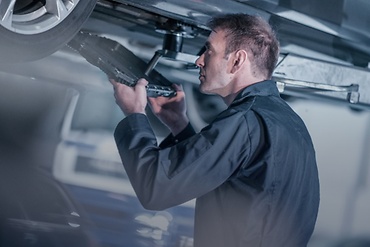
July 5, 2022
5 minutes read
Our experts proudly present
#inbrief
We are the ZF Aftermarket technical support team.
Under the hashtag #inbrief we are going to present you, on a regular basis, a new topic by illuminating it from all angles. These topics may relate to new products or frequent customer inquiries that reach our ZF Aftermarket technical support team. All information on today's topic are available for you to download here.
Do you have a specific question on any technical subject or product information?
Perfect damping in every situation

CDC technology
The impact of damping on a car´s driving comfort and safety cannot be underestimated: Stiff damping ensures good, sporty handling, while soft damping ensures comfort.
SACHS shock absorbers with CDC (Continuous Damping Control) technology stand for perfect damping in every situation.
Behind this is an electronic damping system that noticeably increases driving safety, comfort and dynamics by optimally adjusting the spring tension for each wheel individually.
Benefits in a nutshell

SACHS CDC dampers
- The ultimate in driving safety, comfort and dynamics
- Stability even in critical driving situations
- More control when changing lanes
- Damping force for each wheel adjustable within split seconds
- Reduced stopping distances
- Individually adjustable chassis characteristics
- No special tools required when changing
What´s inside

How SACHS CDC dampers are engineered
- Optimal vehicle vibration behavior: Requires high-quality suspension and damping systems. Suspensions are usually designed progressively in order to be able to adapt to load conditions – at the expense of comfort. Shock absorbers usually have a defined damping characteristic curve and can only be adapted to different load and road conditions to an extent.
- Internal CDC valve: The internal CDC valve is mounted inside on the base of the piston rod. It is connected to the control unit via a cable led through the piston rod.
- External CDC valve: The external CDC valve is mounted outside on the damper tube and connected to the control unit via a watertight plug..
Function in brief

How does CDC work?
In the SACHS CDC damping system, a proportional valve continuously regulates the damping rate. The valve functions like a bypass in the damping hydraulics – depending on the valve setting, the damper can be adjusted between hard and soft.
Via sensors, the electronic control unit can detect speed, lateral acceleration, and road conditions. The system then uses software to calculate the optimum damping force for each wheel – a "cognitive feature" that is put into practice within milliseconds.
CDC technology uses the proportional valve to continuously and precisely adapt the chassis damping to the respective driving situation, making driving easier to manage.
Always in control
How does CDC benefit drivers?
CDC means improved road contact and more safety when driving – the vehicle is more stable. Even in "critical" driving maneuvers at higher speeds (steering, braking, evasive maneuvers), drivers retain full control of the vehicle – without the hard engagement of ESP.
CDC also compensates for load differences – such as full loads at the time of travel: The damping system thus ensures constant driving comfort.

Braking
Especially on poor road surfaces, the improved grip that CDC provides substantially reduces stopping distances.

Evasive maneuvers
In critical driving situations – such as evasive maneuvers – precious milliseconds can be decisive! Here, the CDC system adapts the damper hardness at lightning speed and thus helps the vehicle stay in its lane.
Notes for the workshop
Installation and troubleshooting
If there is an electrical or mechanical fault, CDC dampers must be checked just like conventional dampers and replaced if necessary.
The CDC system is capable of performing a self-diagnosis, but it only recognizes electrical faults, not mechanical malfunctions. In the case of a fault, the CDC indicator lamp on the dashboard lights up.
To narrow down the problem, a diagnostic unit is required. The diagnostic unit can be used to read out and delete the fault memory. Depending on the vehicle, it is also possible to compare the nominal and actual values in order to check the sensors of the CDC system.
When you are installing CDC dampers, always replace them in pairs. To guarantee full functionality, the add-on components – compression buffers, protective tubes and suspension-strut mounts – must also be checked for wear before the dampers are installed.
Every time you install dampers, always replace the service kit (protective tube and compression buffer). Here is another important tip to ensure you replace CDC dampers successfully: Basically, the installation and removal process is the same as with conventional dampers; the only difference is that the electrical plug connections must be loosened and connected again after installation (observe the vehicle manufacturer's installation instructions!).
Tension or strain on the dampers can be avoided by tightening the mounting screws only when the vehicle is standing on its wheels. After that, measure and readjust the wheel geometry if necessary.
After every CDC damper replacement, check the system functions. When the ignition is switched on, the CDC indicator lamp in the car must go out after approximately ten seconds.
And that's it: Your CDC system is ready for use again.
About the authors

The Technical Team
Our technical team for Germany, Austria and Switzerland consists of real troubleshooters: When it matters, they are there!
"Always on the technological pulse!"



